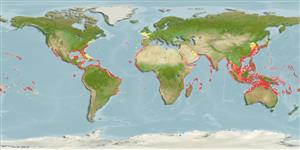>
Tetraodontiformes (Puffers and filefishes) >
Diodontidae (Porcupinefishes (burrfishes))
Etymology: Chilomycterus: Greek, cheilos = lip + Greek, mykter, -eros = nose (Ref. 45335).
More on author: Linnaeus.
Environment: milieu / climate zone / depth range / distribution range
Ecologia
marino associati a barriera corallina; distribuzione batimetrica 20 - 100 m (Ref. 9680). Subtropical; - 24°S, 98°W - 34°W
Circumglobal: Gulf of Mexico, Atlantic, Indian and Pacific oceans.
Size / Peso / Age
Maturity: Lm ? range ? - ? cm
Max length : 69.7 cm NG maschio/sesso non determinato; (Ref. 89467); common length : 30.0 cm TL maschio/sesso non determinato; (Ref. 26999)
Spine dorsali (totale): 0; Raggi dorsali molli (totale): 12-14; Spine anali 0; Raggi anali molli: 11 - 14. Adults grey to brown with a black gular band and small black spots on upper surfaces and fins; pelagic juveniles blue with dark spots above, the spots descending to belly (Ref. 4423).
Adults found in reefs and over soft bottoms to depths of 100 m, but may occur deeper in the tropics (Ref. 30573). Often found washed up on beaches. Known to brace themselves against the substrate to sleep at night (Ref. 4930). Appear to be active during the day. Juveniles often with floating weeds (Ref. 48637). Solitary. Juveniles pelagic in oceanic surface waters (Ref. 30573). Feed on hard-shelled invertebrates. Not usually marketed.
Life cycle and mating behavior
Maturità | Riproduzione | Deposizione | Uova | Fecundity | Larve
Leis, J.M., 2001. Diodontidae. Porcupine fishes (burrfishes). p. 3958-3965. In K.E. Carpenter and V. Niem (eds.) FAO species identification guide for fishery purposes. The living marine resources of the Western Central Pacific. Vol. 6. Bony fishes part 4 (Labridae to Latimeriidae), estuarine crocodiles. FAO, Rome. (Ref. 9680)
IUCN Red List Status (Ref. 130435)
Threat to humans
Venomous
Human uses
Warning: mysqli::__construct(): (HY000/1040): Too many connections in /var/www/html/includes/func_getlabel.php on line 46
Can't connect to MySQL database (fbapp). Errorcode: Too many connections
